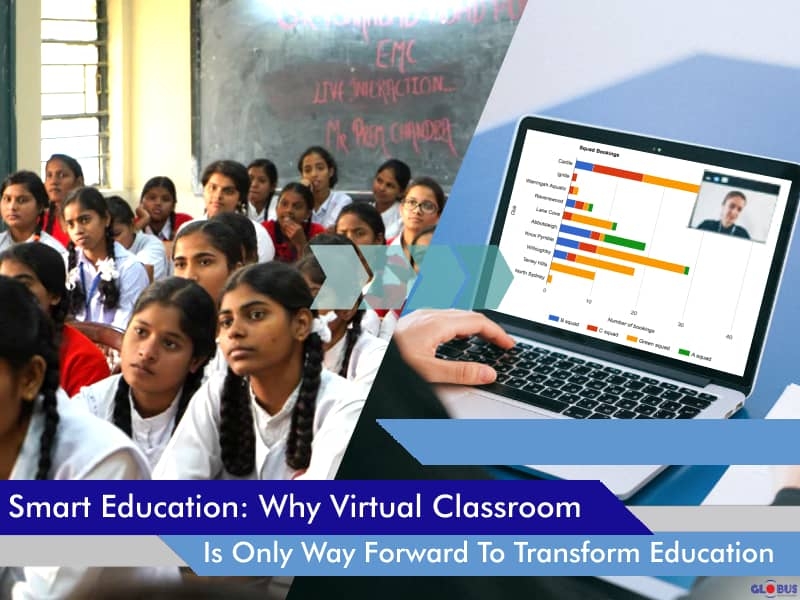Virtual Classroom has become a popular instructional practice among educational institutes across the world. With the pandemic in place, the acceptance of Online Learning Solutions for academic activities picked pace swiftly. It has been observed that the Covid-19 scenario pushed many educational institutes to resort to online learning for maintaining continuity in learning. Rightly so, Remote Learning became a necessity rather than a luxury for educational setups in order to avoid derailment of the academic year.
However, Virtual Classroom or Online Learning Solution is not just a temporary makeshift solution to continue learning process in the view of current situation, but the only way forward to transform Indian education scenario even after the world goes back to normal.

In this blog, we will touch upon myriad of benefits that Virtual Classroom/Online Learning Solutions have to offer.
Quality Education Made Accessible
Previously, when learning was confined to classrooms only, it was difficult for students living in Tier III cities and rural areas to access quality education. However, today the rate of technological progress in terms of education has paved a way for more affordable and accessible learning. With the help of Virtual Classroom or Online Learning Solutions, remote learning has become a feasible and doable phenomenon for majority of students. Even the people living in remote areas of the country can get access to quality education with the help of Virtual Classroom.
The Remote Learning Solution devised by Globus Infocom are designed in a manner to minimise bandwidth consumption and make it ready to use even in places where network infrastructure is poor. The application can be accessed on smartphones and PCs easily to make sure that quality education reaches everyone equally.
Anytime, Anywhere Learning
Virtual Classrooms facilitate anytime, anywhere learning with easy accessibility to content even from mobile devices. It allows learners greater flexibility in terms of time and place of learning. This flexibility means students will get more opportunities to explore and engage with learning material in a better way.
Globus Online Learning Solution's easy-to-use interface allows learners to attend live-classes on the go on their personal devices like smartphones, tablets and PCs. Likewise, a teacher can instruct a large number of geographically-dispersed students at one time, without needing to travel.
Cost-Effective Education
Virtual Classrooms also reduce the overall cost of education. Firstly, students and teachers are not required to travel which saves the cost of travelling and accommodation. Several studies have ascertained that online education or remote learning is significantly more cost-effective than traditional college campus education. Therefore, installing Virtual Classrooms and Online Learning Solutions on a larger scale can provide cost-efficient education to students belonging to different strata of society.
Effective Collaboration
Virtual Classroom is not confined to a handful of students and a teacher confined in a classroom. It provides learners and teachers opportunities to work with each other more than ever before. There are options like private chats, forums, group projects, leader boards, etc. that help students collaborate with their peers in a better way. Additionally, learners can connect with teachers and fellow students across the globe for exchange of knowledge, resulting in an even larger pool of information.
Easy Management of Learning Resources with LMS
With the help of Virtual Classroom and Online Learning Solutions, it is easier and efficient to create, manage and assign learning resources for teachers. The instructors can create learning material like notes, PDFs, presentations, etc. and share it with their students instantly. Also, the assessments and assignments are stored securely on the platform, acting as a Centralized knowledge repository of all the learning-related material. Teachers can devise custom learning material and even monetize over it with the help of the feature called E-Commerce.
Personalized Attention to Every Student
With the help of Learning Management System, teachers can generate reports of assessments and examinations instantly and analyse the problem areas of every student. Personalized attention can be given to each student for their improvement and thereby producing better results. Academic interventions for remedial coaching can be done online thereby cutting down cost. Teachers can directly focus on teaching activities rather than wasting time on clerical tasks like data management.
More Interactivity
Virtual Learning environments create more room for interactivity and collaboration. In traditional lessons, students used to sit in a classroom while listening to a lecture and taking notes simultaneously. It only consisted of auditory stimulus. Whereas, in case of Virtual Classrooms, students’ engagement can be captured by a variety of audio-visual content to give them a better pictures of concepts. Gamified lessons, quizzes, polls, etc. are some of the examples how Virtual Learning have made classrooms increasingly interactive.
Synchronous as well as Asynchronous Learning
Online Learning facilitates both synchronous (real time) as well as asynchronous (offline) learning. Traditional learning only accounts for synchronous learning; which means learners need to be in the classroom to learn. Asynchronous learning means that a teacher can upload course material at one time and learners can access them as per their own schedule. Therefore, Globus Virtual Classroom Solution focuses on both synchronous and asynchronous learning for holistic development of students.
Globus Virtual Classroom Solutions are equipped with a number of features including tamper-proof assessments, live classes, screen recording, interactive whiteboard, screen sharing, e-commerce, interoperability, multiple layout options, etc. to create a life-like classroom environment but with better collaboration and interactivity.


1 Item(s)
Pooja
1 Item(s)